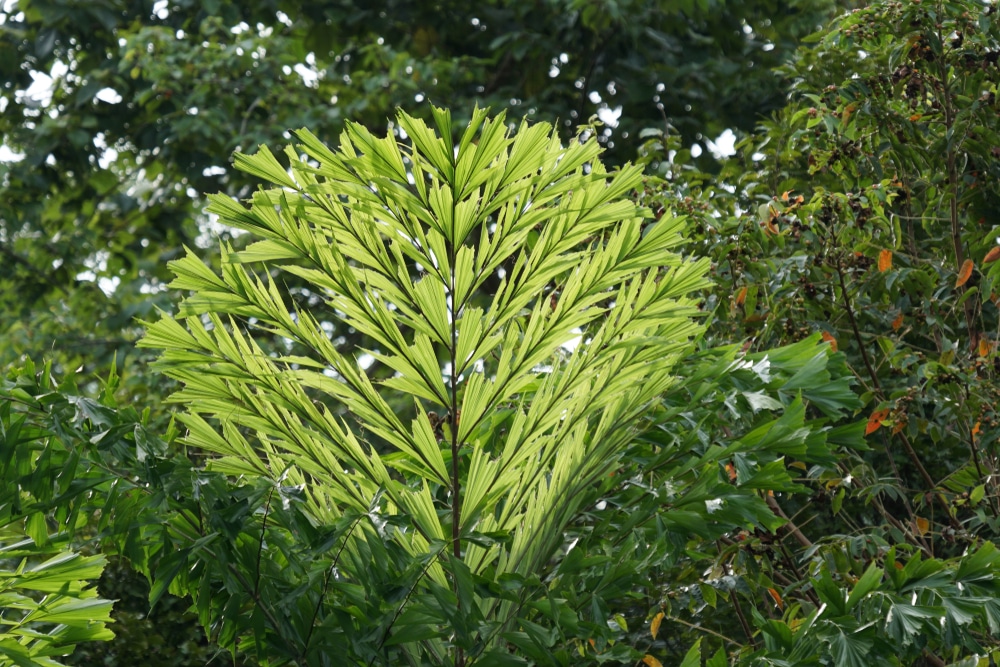If you like palm trees, you might be interested in learning more about the fishtail variety. This tree performs excellently as a houseplant, and you can use it to add a tropical touch to your interiors.
The palm’s name comes from the shape of the foliage, which resembles the fin of a fish.
But before you decide to purchase one, we recommend you keep reading this essential guide. After all, the fishtail palm can be a bit picky about its growing environment. But you don’t have to worry: there is nothing too challenging to accomplish! Read on to learn all you need to know about this plant!

| Botanical Name | Caryota mitis |
| Common Name | Fishtail Palm |
| Plant Type | Perennial |
| Flower Color | In nature, this palm produces flowers that resemble a mop head and sprout in a clump. However, once the tree has fruits, the trunk will die. |
| Size When Mature | Up to 10 feet tall and 3 feet wide |
| Bloom Time | Not applicable |
| Sun Requirements | Bright, indirect light |
| USDA Hardiness Zones | 8-11 |
| Soil PH Range | Between 6.0 and 7.5 |
| Soil Type | Well-draining, moist, and fertile |
| Water Needs | Medium |
| Native Area | South East Asia and Southern China |
What you Need to Know About Fishtail Palm
Palm trees are an excellent way to add a jungly touch to your house. While there might be less tricky varieties to grow, fishtail palms are so gorgeous that they are worth the challenge.
There are about 12 species of fishtail palms. The plant is native to the tropical forests of South East Asia, and interestingly enough, it is now invasive in parts of Australia, Florida, and Hawaii.
The palm’s foliage resembles the tail of a fish. Also, the leaves are waxy. Under ideal conditions, fishtail palm will grow between 6 and 10 feet tall inside. In nature, it might get as tall as 40 feet.
Additionally, while the plant flowers outside, it will rarely bloom as a houseplant. And even if it does, we recommend you to be careful when handling the fruits: they contain toxic substances that are highly irritating.
How to Care for Fishtail Palm
Now that you know a little bit more about the plant, you may be curious to learn how to care for a thriving fishtail palm. So, look no further: you will find all you need to know to make the most out of your plant in the following sections.
Light
Fishtail palms can be a bit tricky with lighting. Indeed, most problems with these plants are a result of inadequate lighting. Fishtail palms need lots of indirect sunlight but don’t do well under the sun. So, if you are growing them outdoors, pick a location that only gets light in the morning.
Indoors, you’ll have the best results placing your palm next to an east-facing window. If the location is too bright, consider getting shears. Also, don’t forget to rotate the container to ensure an even growth pattern.
Water and Soil Needs
Keep your fishtail palm moist but without overwatering it. To avoid issues, only add extra moisture when the soil feels dry (use your fingers to test it!). Also, pick a well-draining potting mix for growing your plant. You can purchase a product for cacti or make your own by mixing perlite, sand, and a general potting mix.
Consider adding mulch around your plant to increase drainage and improve water retention.
Temperature Requirements
These plants need warmth to thrive. After all, they are native to the tropical forests in South East Asia. So, you should only grow them outdoors if you live in USDA hardiness zones between 8 and 11. But if you don’t, you can always grow them as houseplants.
Just ensure that the temperatures in your home stay between 65 and 85°F. Avoid exposing these tropical plants to conditions below 55°F: the cold might kill them.
Additionally, the place must be humid to resemble the conditions these plants naturally find in their habitat. So, avoid placing them next to the AC or drafty windows.
Fertilizer
To boost your palm’s growth, you should add a liquid fertilizer during the growing season (in the spring and summer).
Common Diseases
As a houseplant, you won’t have to worry too much about attacks from pests and bugs. However, you’ll need to pay attention to spider mites outdoors. Besides, follow a steady watering schedule and keep an eye on your plant. And if you notice something off with it, or the leaves are yellow, take prompt measures to minimize damages.
Fishtail Palm Propagation
You can propagate your fishtail palm from seed or division. Luckily, the process isn’t too challenging either way, so once you have a thriving palm, you’ll be able to get more “sons” to decorate your house or give to your friends.
The easiest method is to divide your plant. You can do so once your palm has at least four stems. Then, all you have to do is gently pull a side apart without harming the roots. You may have to use some shears to cut some of the knots. Place your division into a container with a well-draining potting medium and keep it well-watered.
Alternatively, you can buy seeds online or at some garden stores if you don’t live in a tropical region and plant them in suitable containers. The trick is to place them under plenty of bright and indirect light and keep them moist to boost germination.

